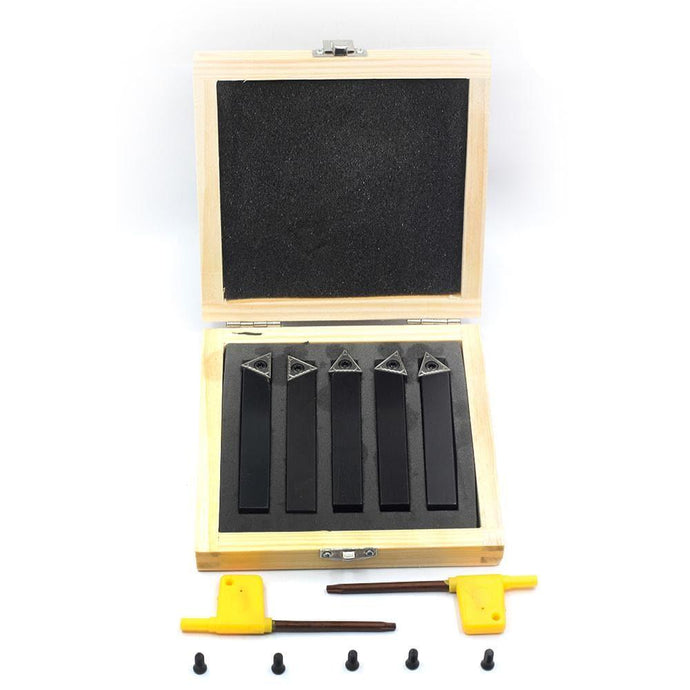
Turning Tools for Metal Lathe: The Backbone of Precision Machining
In the world of machining, few tools are as fundamental as the turning tool for metal lathes. These tools are the primary instruments used to shape and refine metal workpieces, transforming raw material into precision components that meet the most stringent tolerances. Whether crafting intricate parts for machinery, automotive components, or aerospace engineering, turning tools are the key to achieving high levels of accuracy, efficiency, and surface quality. They play a pivotal role in the metalworking industry, making them indispensable for both hobbyists and professional machinists alike.A metal lathe, which utilizes turning tools to perform cutting operations, is one of the most versatile machines in the workshop. The turning process involves the rotation of the workpiece while a stationary cutting tool is used to remove material, shaping the workpiece into the desired form. Depending on the type of cutting tool used, this process can achieve various results such as turning, facing, boring, and threading. Turning tools for metal lathes are designed to be sharp, durable, and capable of withstanding high speeds and forces, ensuring that each pass cuts the metal with precision and consistency.
The most common turning tools for metal lathes are classified based on their geometry, material, and function. One of the most popular categories is the single-point cutting tool, which is used for general turning operations. These tools have a pointed tip that engages the workpiece at a specific angle, allowing them to cut a variety of shapes and contours. Single-point tools are ideal for roughing and finishing operations, where the cutting edge is adjusted to achieve the desired finish. These tools are often made from high-speed steel (HSS), carbide, or cermet, each material offering different levels of wear resistance and heat tolerance. Carbide tools, for example, are known for their durability and ability to cut at higher speeds, making them a favorite for production work that demands both speed and precision.
For specific tasks such as creating threads or grooves, specialized turning tools come into play. Threading tools, designed to cut helical threads into a workpiece, are an essential part of the turning tool arsenal. They have a precisely shaped profile that matches the thread geometry and can be used to create internal or external threads with high accuracy. Similarly, grooving tools are used to cut narrow channels or grooves along the surface of the workpiece, which is vital for applications such as snap rings, seals, or bearing surfaces. Grooving tools often feature a sharp, narrow cutting edge that allows them to create clean, precise cuts in the material without damaging surrounding areas.
Another important category of turning tools is the parting tool, which is used to separate a part from the workpiece. Parting tools are characterized by their thin, blade-like design, which enables them to cut through material quickly and efficiently. These tools are essential for cutting off finished parts from long bars or blanks, and they are often used in conjunction with other turning tools in a multi-step process to complete complex parts.
The choice of material for turning tools is critical in determining their performance and longevity. High-speed steel (HSS) tools are known for their versatility and are often used in situations where a variety of materials are being turned. However, HSS tools tend to wear out faster at high cutting speeds, which is where carbide tools come in. Carbide turning tools are much harder and can withstand higher temperatures, allowing them to perform faster and last longer. For particularly demanding applications, tools made from cermet - a combination of ceramic and metal - offer an even harder, more durable option for high-precision turning operations.
The design and setup of turning tools are also essential for achieving optimal results. Toolholders are used to mount and support the turning tools on the lathe. They allow the operator to adjust the tool's position and angle, ensuring that the cutting edge is correctly aligned with the workpiece. Proper toolholder setup is crucial in maintaining tool stability and minimizing vibrations during cutting, which can negatively impact the finish quality and precision of the workpiece.
Turning tools for metal lathes also come with a variety of coatings that help enhance their performance. Coatings such as titanium nitride (TiN), titanium carbonitride (TiCN), and diamond-like carbon (DLC) are commonly applied to cutting tools to increase wear resistance, reduce friction, and improve surface finish. These coatings help the tools perform longer, especially in high-heat or high-speed cutting operations, which can significantly reduce the frequency of tool changes and downtime in a production environment.
One of the advantages of turning tools for metal lathes is their ability to be re-sharpened or reconditioned. While tools made from materials like carbide or HSS can wear out over time, many machinists choose to re-sharpen their tools to extend their useful life. This not only saves money but also allows for the continued use of tools that have been fine-tuned to specific machining tasks. However, some carbide tools may not be easily re-sharpened, as their hardness makes them difficult to grind.
Turning tools for metal lathes are essential to the precision and efficiency of machining processes, and their variety ensures that machinists can tackle a wide range of tasks. Whether it's turning, grooving, parting, or threading, there is a turning tool specifically designed for the job. The advancements in materials, coatings, and tool design continue to enhance the performance of these tools, allowing machinists to achieve higher productivity, longer tool life, and superior surface finishes. For anyone working in the world of metal machining, turning tools for metal lathes are at the heart of the craft, ensuring that each part is shaped with precision and accuracy, ready to meet the most demanding requirements.